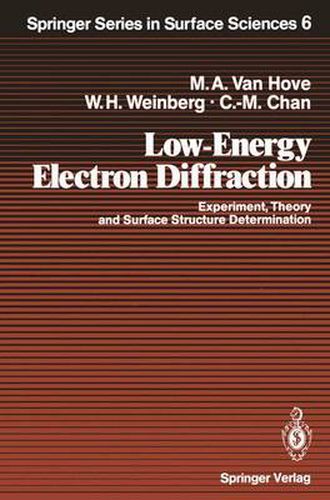Readings Newsletter
Become a Readings Member to make your shopping experience even easier.
Sign in or sign up for free!
You’re not far away from qualifying for FREE standard shipping within Australia
You’ve qualified for FREE standard shipping within Australia
The cart is loading…






This title is printed to order. This book may have been self-published. If so, we cannot guarantee the quality of the content. In the main most books will have gone through the editing process however some may not. We therefore suggest that you be aware of this before ordering this book. If in doubt check either the author or publisher’s details as we are unable to accept any returns unless they are faulty. Please contact us if you have any questions.
Surface crystallography plays the same fundamental role in surface science which bulk crystallography has played so successfully in solid-state physics and chemistry. The atomic-scale structure is one of the most important aspects in the understanding of the behavior of surfaces in such widely diverse fields as heterogeneous catalysis, microelectronics, adhesion, lubrication, cor rosion, coatings, and solid-solid and solid-liquid interfaces. Low-Energy Electron Diffraction or LEED has become the prime tech nique used to determine atomic locations at surfaces. On one hand, LEED has yielded the most numerous and complete structural results to date (almost 200 structures), while on the other, LEED has been regarded as the technique to beat by a variety of other surface crystallographic methods, such as photoemission, SEXAFS, ion scattering and atomic diffraction. Although these other approaches have had impressive successes, LEED has remained the most productive technique and has shown the most versatility of application: from adsorbed rare gases, to reconstructed surfaces of sem iconductors and metals, to molecules adsorbed on metals. However, these statements should not be viewed as excessively dogmatic since all surface sensitive techniques retain untapped potentials that will undoubtedly be explored and exploited. Moreover, surface science remains a multi-technique endeavor. In particular, LEED never has been and never will be self sufficient. LEED has evolved considerably and, in fact, has reached a watershed.
$9.00 standard shipping within Australia
FREE standard shipping within Australia for orders over $100.00
Express & International shipping calculated at checkout
Stock availability can be subject to change without notice. We recommend calling the shop or contacting our online team to check availability of low stock items. Please see our Shopping Online page for more details.
This title is printed to order. This book may have been self-published. If so, we cannot guarantee the quality of the content. In the main most books will have gone through the editing process however some may not. We therefore suggest that you be aware of this before ordering this book. If in doubt check either the author or publisher’s details as we are unable to accept any returns unless they are faulty. Please contact us if you have any questions.
Surface crystallography plays the same fundamental role in surface science which bulk crystallography has played so successfully in solid-state physics and chemistry. The atomic-scale structure is one of the most important aspects in the understanding of the behavior of surfaces in such widely diverse fields as heterogeneous catalysis, microelectronics, adhesion, lubrication, cor rosion, coatings, and solid-solid and solid-liquid interfaces. Low-Energy Electron Diffraction or LEED has become the prime tech nique used to determine atomic locations at surfaces. On one hand, LEED has yielded the most numerous and complete structural results to date (almost 200 structures), while on the other, LEED has been regarded as the technique to beat by a variety of other surface crystallographic methods, such as photoemission, SEXAFS, ion scattering and atomic diffraction. Although these other approaches have had impressive successes, LEED has remained the most productive technique and has shown the most versatility of application: from adsorbed rare gases, to reconstructed surfaces of sem iconductors and metals, to molecules adsorbed on metals. However, these statements should not be viewed as excessively dogmatic since all surface sensitive techniques retain untapped potentials that will undoubtedly be explored and exploited. Moreover, surface science remains a multi-technique endeavor. In particular, LEED never has been and never will be self sufficient. LEED has evolved considerably and, in fact, has reached a watershed.